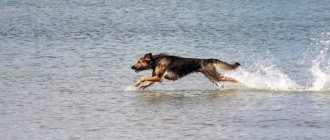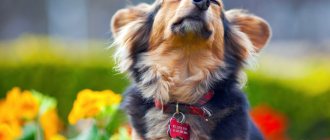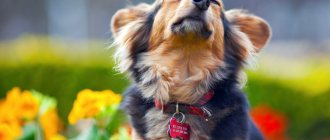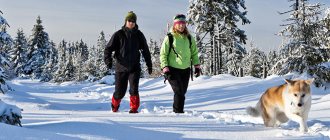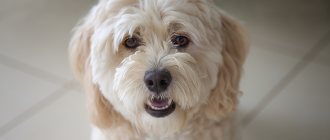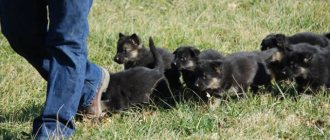Walking is one of the most joyful moments of a dog’s daily routine. Not only because your pet will be able to relieve itself. This is also one of the important elements of dog socialization. During a walk, he meets other representatives of his kind, explores new territories, and gives free rein to his nature. A new owner should know how to walk a dog correctly so that both receive a boost of good mood and energy.
Each owner forms his own habits. Some people prefer to go for short but frequent walks. Others can walk for an hour and a half. Some people try to combine a trip to the store or meeting with friends with a walk.
Without a walk, the dog will get bored, and short runs will not do it any good. The meaning lies in the very ritual of communication between the owner and the pet. During such walks, they understand each other better, relax, and gain energy for other types of activity. Therefore, you should figure out how much you need to walk in the park with your dog, make a daily plan and stick to it.
Why walk your dog?
Walking is one of the natural needs of animals. There are a number of reasons for this:
- Socialization. Your pet cannot live without society. He needs to communicate with other representatives of the species. Without this, its full development as an individual is impossible.
- Physical health. Dogs need exercise. Without this, the musculoskeletal system will suffer and the muscles will lose tone. The pet's activity will decrease, it will become dull and lethargic. The opposite manifestation is also possible – increased aggressiveness.
- Mental stability. Without exercise, the dog gets bored and its mood worsens. She won't know what to do with herself in the apartment. It may even lead to damage to property or harm to the owner.
The question arises: how long should you walk your dog for it to feel good? It all depends on many different factors. First of all, take into account your work schedule and also take into account the breed of your pet. For decorative ones, a short walk is enough to communicate with relatives and relieve themselves. For larger ones, full physical activity will be required in the form of jogging or any other activity.
When to feed the puppy: before or after a walk?
The digestion process for dogs is not fast. From the moment food enters the pet’s stomach until it is completely processed, several hours pass. And during this process the animal needs to be at rest.
After feeding, the puppy will not be as active and will not want to explore the world around him. It is difficult for a dog to move around with a full stomach, and this can lead to volvulus. Therefore, it is not recommended to feed the puppy before a walk.
.
The first thing a small pet needs to do in the morning is to go to the toilet and get rid of everything that has accumulated during the night. After the puppy has satisfied all its needs and has taken an active walk, it will begin to eat food with great appetite. At a young age, dogs develop proper eating behavior. During this period, it is especially important to pay attention to feeding the puppies.
The body of a small pet requires a balanced diet containing vital vitamins and minerals. PRO PLAN® ready-made food specially designed for puppies helps to form correct eating habits. They contain all the necessary components for the growth and development of puppies of any breed.
How long should the walk last?
Beginners do not know how long a dog can tolerate before the next walk. Typically, an adult pet can wait up to twelve hours before the next walk. Walking your dog in the park twice a day is enough – in the evening and in the morning. If there are any health problems, the number of walks may vary. For example, animals with a disease of the genitourinary system require going outside more than four times.
Puppies will take a lot of work - you need to go outside with them every few hours. Otherwise, he will not be able to cope with his physiological needs. Over time, the interval will increase to six or more hours. You should make a schedule for how many times a day to walk your dog.
The duration of the walk largely depends on the breed and age of the pet. Small decorative dogs can be walked for about two and a half hours. For large breeds it will take a little longer - 2-3 hours. This requires intense physical activity. They enjoy long runs or active games. Come up with something interesting.
How to walk your dog correctly
See also What to do if your cat or dog is lost
“There is no creature more devoted than a dog, more affectionate than a dog, more cheerful than a dog!” Many people remember the lines of the song from the film “The Adventures of Electronics”. Dogs bring variety to our everyday life, the joy of communicating with a four-legged shaggy friend, and even teach discipline. But sometimes dogs cause people around their owners a lot of trouble: they irritate, frighten, even attack and bite.
Yevgeny Yushchenko
08:13, 11 May 2021
“Novosibirsk News” has prepared a small instruction on how to accustom your dog to daily walks and how to behave correctly with your pet during the promenade.
Train your dog for walks
This is one of the most important moments in raising a pet.
When going for a walk, put a collar and leash on your dog. Over time, this will become a sign for the dog: it’s time to go for a walk. The collar should be fastened tightly, but not tightly: 1-2 fingers should fit between it and the animal’s neck. Train your dog to use characteristic phrases and commands. Pull the leash towards you and say loudly and clearly: “Walk!”
Talk to your dog while walking too. If the dog is playing around or acting aggressively, use a stern, commanding voice; if he is obedient and friendly, praise him. For example, words such as “well done”, “good” and other similar ones are suitable.
If your dog is constantly rushing from side to side, teach him the command “Next!” It must be pronounced strictly, while pulling the leash so that the dog ends up in the indicated place.
By the way, you need to determine in advance which side of you your pet will be on during a walk, and it is not recommended to change this side. Just determine which side is more convenient for you to be on, so that if something happens, you can pull the dog away. For obedience, you can reward not only with a word, but also with a small piece of treat (meat, cheese, strawberries, seeded watermelon, chopped apples, blueberries, carrots). But be consistent so that your pet understands why exactly he received the treat.
Photo: nsknews.info
Change your walking route
Try to change your walking route regularly. This is not so much for the sake of variety of impressions, but so that the dog can remember as many ways to the house as possible. If your pet ever gets lost, he will have a better chance of finding a home. But this should be done only after the dog has learned the main route. Otherwise, she will think that something went wrong and will be nervous and worried.
Photo: Rostislav Netisov, nsknews.info
Consider weather conditions
Don't walk your dog in the heat. First, dogs are susceptible to heatstroke, so summer walks in the hot sun can be dangerous. And secondly, in the summer the asphalt gets very hot, and the dog can burn his paws. Before you go for a walk, check the asphalt: just put your palm on it.
Small dogs need to be dressed in special clothing in winter. Pet stores have a wide range of different overalls for pets. If the dog is less than six months old, then clothing will provide comfortable protection for it when it just starts to get cold.
And don't forget about winter shoes. The interaction of paw pads with reagents that are sprinkled on roads in winter can result in skin burns.
Photo: Rostislav Netisov, nsknews.info
Use a leash and muzzle
As for the leash, the dog should be on it almost always, unless we are talking about special places for walking and training animals. When crossing the road, your pet must be kept on a short leash.
Wearing a muzzle is regulated by Federal Law No. 498 “On the Responsible Treatment of Animals,” changes to which came into force in 2022. According to this law, large (German, Caucasian and East European shepherds, Rottweilers, etc.) and potentially dangerous dogs must be muzzled.
The list of potentially dangerous breeds is established by a decree of the Russian government. There are 12 such breeds in total:
- Akbash;
- American Bandog;
- ambuldog;
- Brazilian Bulldog;
- bulli kutta;
- Alapaha purebred bulldog (Otto);
- bandog;
- wolf-dog hybrids;
- wolfdog (wolf hybrid);
- gul dong;
- Pit Bull Mastiff;
- North Caucasian dog.
Mixed breeds of all these breeds are also considered potentially dangerous.
Dogs with a height of more than 40 cm at the withers are considered large. They need to wear not only a leash, but also a muzzle.
There is a fine for walking a dog without a muzzle. Children under 14 years of age are prohibited from walking with animals unless accompanied by an adult. People who are drunk are also not allowed to walk their dogs, even if their pet is on a leash and muzzled.
And finally, a muzzle is not only a means of restraining a dog, but also protecting it. During a walk, the dog can pick up some nasty stuff from the ground and swallow it. But this could be real poison, deliberately scattered. Unfortunately, such facts are not uncommon today.
But in full equipment, the dog cannot be walked in those places that the authorities have classified as inappropriate for this purpose.
Moreover, the new law prohibits walking a dog, even if it is on a leash and muzzle, unless the owner's telephone number or address is indicated on the collar. There should also be a tag with the animal's number.
Photo: Pavel Komarov, nsknews.info
Maintain silence
The time allotted by law for walking dogs is from 7:00 to 23:00. Of course, no one forbids being outside with a dog at earlier or later hours. But you need to walk your pet without violating the silence regime, which is defined from 23:00 to 7:00.
Walk in permitted places
There are very few specialized, fenced-in places for walking and training dogs, even in such a big city as Novosibirsk. At the same time, the law prohibits walking dogs even in parks and squares where there may be people. For legal walks, only vacant lots between houses remain. But even there, of course, you need to walk with great caution, ensuring the safety of others as much as possible.
You are not allowed to be with your dog on sports and playgrounds, beaches, in the territories of kindergartens and schools, hospitals and clinics, in the courtyards of apartment and high-rise buildings, in industrial zones, as well as in cemeteries. Prohibited places also include crowded streets.
The fine for walking dogs in unauthorized places ranges from 500 to 1,000 rubles, and for a repeated violation - up to 3,000 rubles.
You can only take your dog into non-food stores if there are no prohibiting signs at the entrance. If there are any, then the dog must remain outside - on a leash in a muzzle. The only exceptions are guide dogs that accompany visually impaired people.
Photo: Pavel Komarov, nsknews.info
Clean up after your pets
The situation with the so-called dog boxes—special boxes into which bags of dog feces must be thrown—is about the same as with special walking areas, if not worse. You can meet them extremely rarely.
However, it is necessary to clean up your pet's excrement; this is the law. Failure to comply with this requirement is punishable by a fine of 500 to 1000 rubles. If the dog relieves itself on the playground, the fine will be doubled. So don't forget to take plastic bags when walking your dog.
Where to throw away bags of feces in the absence of dog boxes? This, oddly enough, is a more complex question.
Dog excrement is classified as low-hazard waste. But can they be thrown into regular trash bins? On the one hand, there is nothing about excrement in the Veterinary and Sanitary Rules for the collection, disposal and destruction of biological waste. On the other hand, they are often equated to biological waste, so they can actually be fined for using an ordinary trash can. But this is much less likely than if you don’t remove it at all and throw it away. So the answer suggests itself: it is better to collect your dog’s waste products in a bag and throw them in a regular trash bin than not to do this.
Subscribe to our Facebook page - stay up to date with the latest news from Novosibirsk.
#Instructions #Animals #Useful city #Cute city #Safety
What rules should you follow?
To make walking as effective as possible, the following recommendations should be followed:
- Choose multiple routes. Calculate the amount of time you need to complete the journey. Develop a habit that will help you manage your daily schedule rationally in the future.
- Make a plan for how many times you need to walk your dog. If you don't have much time, compare possible routes and find the best solution.
- It is recommended to spend most of the full walk without a leash. Otherwise, you will not provide your pet with the required level of activity.
- You should walk your dog on a leash for some time. This will help control his actions, and will also not tire him out much during the walking process. Your pet should be allowed to run freely only in cases where it is well trained in all basic commands.
- Many people don’t know whether to walk the dog before or after meals. You should go for a walk on an empty stomach. After walking, feed your pet. It is advisable to do this not immediately, but about 20-30 minutes after returning home.
Try not to overload your pet. Of course he needs to run, but don't make him do it for too long. A healthy dog can run at a fast pace for about ten minutes.
How to prepare a puppy for a walk
While the puppy is undergoing home quarantine after vaccinations, there is time to pay attention to preparing for leaving the house. The young explorer will learn a lot of new things during his walks, so start raising your puppy early.
Learn basic commands
Discipline is required from the dog during walks, and this primarily concerns the safety of the pet. With the help of commands, behavior patterns are formed. This takes time, so start introducing teams at home. For the street, the following commands are useful: “Nearby”, “Come to me”, “Ugh”, “Walk”.
Get used to a collar and leash
Dog equipment is needed to control your pet while walking. In addition, a collar with a leash is required by law. The leash will not allow the puppy to run away and will help the owner to pull the pet back in case of danger.
Choose the first collar according to the size of the puppy; it is definitely not worth taking for growth. The puppy should feel comfortable in the collar; give preference to soft and lightweight models. The leash should not be too long. Avoid buying chains and tape measures that make scary sounds.
Carefully secure the collar around the puppy's neck. Tighten it so that it is not tight and does not fall off due to the movement of your pet's paws. Give time to get used to the new sensations. When the collar stops attracting the puppy's attention, begin leash training. First, you can use a small cord with which the baby can walk around the house. Then periodically pull it on, simulating a walk with a leash.
What is important to consider when getting acquainted with ammunition
:
- new accessories must first lie down and remove foreign odors,
- let the puppy sniff the collar and leash, then try it on,
- prohibit playing with ammunition, much less chewing on it,
- train your puppy in a playful way, maintain a friendly attitude,
- It is strictly forbidden to hit the puppy with a leash,
- reinforce correct behavior with treats,
- Do not leave your puppy unattended with a leash attached.
Introduce the muzzle
Does a puppy need a muzzle? On the one hand, you don’t want to put this accessory on your puppy. On his first walks, a huge number of impressions fall on him. A muzzle on the nose can cause discomfort. On the other hand, one day you will still need to wear it: if you need to travel on public transport or go to an appointment with a veterinarian.
If your puppy constantly picks things up from the ground, a muzzle will help protect his health. This accessory will be useful for dogs of large and fighting breeds. Use a muzzle based on your dog's needs and when required by law. Introduce the muzzle according to the same rules as with the collar and leash: gently, friendly and stress-free.
What does a full walk include?
Let's figure out how to properly walk a dog. This is a kind of ritual, which must include the following actions:
- do all the dog's business;
- run several times for at least ten minutes;
- communicate with other representatives of the canine family;
- walk next to the owner to strengthen the psychological connection;
- teaching several new commands and reinforcing old ones - prepare some kind of treat as an incentive surprise.
This is a complete procedure, like walking a dog. This walking scheme will benefit both the owner and the pet. The dog will visit new places, communicate with relatives, run, and relieve itself. He will be tired enough to rest when he gets home. Of course, it is not always possible to allocate the required amount of time for a full walk, but it is still worth trying to find a “golden mean”.
Examples of walking activities
There are many options for what to do on a walk to provide your dog with the necessary level of physical and mental stress:
- Repetition or mastery of commands. If the dog has not yet completed a general training course, then first of all practice the basic commands: “Come to me”, “Nearby”, “Sit”, “Lie down”, etc. The next stage is the complication of basic commands: training endurance, stopping or landing from movement, calling when distracted, etc. And of course, you can learn tricks while walking. They will provide both physical and mental stress, and will also be an excellent way for owner and pet to communicate. Start with simple exercises and then move on to more complex ones.
You can combine learning tricks and basic commands. This will keep your pet at a high level of motivation to learn.
- Importation. It is not necessary to turn fetching into a boring and monotonous activity. You can throw the ball up a hill or into a pond (provided the pond is safe and the weather is warm) to add variety to the game and force your dog to exert a little more effort than usual. You can also teach your pet to catch a Frisbee.
- Obstacle course . Obstacles can be any objects that come your way (make sure they are safe). For example, with the command “Jump” the dog needs to jump onto a stump, and with the command “Boom” - it needs to jump onto the curb and run along it. A fallen tree can be used as a Barrier command to make the dog jump over it. Make the route an obstacle course - animals really like such games.
- Search games. Your task is to hide the toy, and the dog’s task is to find it and bring it to you. Every time an animal brings an item, praise it and begin to actively play with the find. Try to make your search more difficult each time.
- Shaping. This method of training is similar to the game of “hot and cold”. The owner comes up with what exactly the dog should do and directs it using clickers (or voice markers). For example, there is a bench in front of you and you want the dog to jump on it. First, you click simply for looking at the bench, then for a step in its direction, and so on, until you achieve the intended behavior - jumping onto the bench.
When engaging in various types of exercise, monitor your dog’s condition. If you see that she is tired and clearly wants to rest, do not force her to continue classes.
While performing tasks, it is important not to forget to give treats - this is an imitation of hunting: receiving food (sweets) for intellectual and physical efforts. Also, be sure to reward your pet if he independently offers you any actions - for example, jumps on a log and waits for your reaction. This way you will show that you approve of the initiative and desire to interact with you.
Please note that this last recommendation only applies to dogs that are not going to undergo serious training and that do not have behavioral problems (which are currently being corrected). If you are preparing your dog for exams or working on behavior correction, then such actions on your part can lead to the fact that he begins to shy away from difficult commands and switch to easier ones.
The dog's manners are an important factor in the walk.
To make the walk effective, you should teach your pet basic commands. You can let him off the leash and let him run around. The dog must know and respond to two phrases - “stand” and “toe”. During each walk, try to teach him something new so that not only his body, but also his intellect develops.
There are many manuals that present teaching methods. You no longer have to walk your dog on a leash. You can safely let her go for a run and explore the area on her own.
Returning from a walk
After a walk, don't forget to wipe your puppy's paws with a damp cloth. If the weather is damp and dirty, you will have to wash not only the paws, but the entire puppy. This important rule of hygiene is associated not only with the cleanliness of the pet and the apartment.
While walking, your dog may step into a puddle containing a chemical, such as gasoline. In winter, the dog will walk on roads sprinkled with reagents. The puppy can also cut himself, get a splinter, or bring ticks on his skin. Therefore, after a walk, wash your paws and inspect them for damage and foreign objects.
It is also recommended to accustom your puppy to water procedures from an early age and reward him with treats for good behavior during washing. For severe stains, use special detergents for dogs. Monitor the water temperature; it should not differ sharply from the street temperature. After a bath, be sure to wipe your paws with a dry cloth to prevent your puppy from slipping on the tiles and getting injured.
After the bath, it's time to feed your pet, and then leave him alone and let him rest. Gradually the puppy will get used to walks and all the accompanying processes. The main thing during this period is to be patient and support your pet in its first steps into adulthood.
How to avoid problems?
In order for you and your pet to have complete mutual understanding, constant training and discipline are required. This is the only way you can achieve the desired result, earn trust and have a good time with your favorite animal.
Show leadership
First, you will definitely need to create a walking strategy. It is quite common for the pet to lead the walk, not the owner. To avoid this, you need to show your dominance.
If the dog tries to chart his path, stop these attempts by calling him to you. In cases where he tries to run away for a long distance, call him back. This way your pet will always remember your presence.
Encourage your pet the moment he runs up. This will help build trusting relationships. The dog will know that you have something tasty for him.
You can practice playing with some kind of toy. Throw it at a distance, the dog must grab the object and return it back. This is a fairly common training tactic.
Which dogs can you refuse a daily walk with?
Owners of small and dwarf breeds may refuse daily walks. These pets include Japanese Chins, Chihuahuas, Pomeranians, Shih Tzus and other babies. All of them easily get used to the tray and quite quickly spend the energy accumulated during the day after several laps around the room.
This group also includes larger representatives - pugs. These four-legged animals have very low activity. They are so lazy that you have to work hard to get them outside. The pug is walked only to maintain normal weight.
Health and joy of a full walk
By following simple rules on how to walk your dog, your pet will be happy. This will bring joy to you too. Daily walks will strengthen your health, immunity, and lift your spirits.
A properly raised dog will make your life calm and measured. An hour and a half walk will allow you to concentrate on your thoughts and abstract from the outside world.
The efforts put into education will not be in vain. You will get a great friend to have fun with. Now you know how often to walk your dog. Make an individual plan and try to stick to it in order to establish a unified routine for you and your pet.
Pet walking schedule
Walking dogs has to be adjusted to the schedule of their owners, and there is nothing wrong with that. Some take long walks with their pet in the morning, others in the evening before bed. And the rest of the walks are shorter, at different times during the day.
Here's what a dog walking schedule might look like:
- 6.30 –7.00 – a short morning walk near the house;
- 14.00–14.20 – short walk in the middle of the day;
- 19.00–20.00 – intensive evening walk with physical activity and games;
- 23.00–23.30 – short walk before bedtime.
This is just an example. Each dog owner sets his own walking schedule, depending on his employment, dog breed, weather conditions and other circumstances. However, there are rules that it is advisable for everyone to follow at all times.
Rule 1
Try not to change the established schedule for walking your dog - pets react poorly to such changes, get worried and can prepare an unpleasant surprise in the apartment (that is, they cannot tolerate it).
Rule 2
One walk a day should be longer, preferably at least 1–1.5 hours. During this walk, you can change the route, go further, in search of new experiences. The dog must receive sufficient physical activity and emotional release.
These are general recommendations for the time, frequency and duration of walks, so do not forget about the individuality of each dog. Like people, our little brothers differ greatly from each other in temperament and character.
There is no need to blindly follow the requirements for a particular breed. Be attentive to your pets, observe their behavior, preferences and habits in order to develop a special walking regime that is comfortable for your dog.
When can a puppy walk outside without vaccination?
The availability of vaccination directly determines how many months you can walk with your puppy. If the baby has already been separated from his mother, but has not yet been vaccinated, then he is strictly forbidden to communicate with other animals and pick up objects from the ground. These conditions are easily met in the local area of a country house. Before walking, the yard must be thoroughly cleared of debris and hazardous objects.
If you live in the city, take your pet for a walk in your arms. Make sure the weather is warm and dry before heading out. Otherwise, the baby may catch a cold and get sick.
The importance of walking for animals
Before you figure out at what age to walk your puppy, you need to note the importance of walks. Thanks to them we can:
- Accustom your pet to communicate with other people and animals. Timely socialization suppresses aggression and cowardice.
- Maintain or improve your physical fitness. Regular going outside keeps not only pets, but also their owners in good shape.
- Stabilize mental state. The lack of new emotions affects obedience and exacerbates feelings of loneliness. A dog with a walk can tolerate separation much easier and is much less likely to suffer from destructive behavior.
- Stimulate the body's functioning. Fresh air saturates the brain with oxygen, improving the functioning of the cardiovascular system and all internal organs.
Please note that walking should be supplemented with training and games. This facilitates the educational process and strengthens attachment.
Fine for violating the law on walking
The punishment for violating the new law differs in different regions, since it is not specified in its text, but depends on the Code of Administrative Offenses (CAO) in force in the territory of the subject of the federation - city, region, republic or territory.
Walking pets is prohibited
In this regard, it is worth noting the following:
- in Moscow, monetary penalties range from 1–2 thousand rubles;
- the authorities of St. Petersburg considered it necessary to double the amount of payment and fine violators of the rules for walking dogs in the amount of 3 to 5 thousand rubles;
- The Krasnoyarsk Territory makes exceptions for those who perform official duties with a dog; for other owners, the monetary penalty will be 1–5 thousand rubles;
- There is a similar situation with fines for walking dogs illegally in the Krasnodar Territory.
Fine for walking a pet in the wrong place: subtleties
Graduation has not yet been adopted in the Moscow region. But there is reason to believe that public outcry will accelerate the adoption of a system of administrative penalties, taking into account the specifics of rural areas and the type of settlement. The problem will be resolved based on the Moscow experience.
Rules for keeping dogs
The government of St. Petersburg has long ago adopted the Law on Administrative Offenses, according to which the provisions of the new federal regulatory document have long been implemented. In 2004, in St. Petersburg, a document was published by the Committee for Improvement, which explicitly prohibits walking dogs and any other pets.
The parks and squares of the magnificent city are now patrolled by Committee inspectors, who are still warning owners about the legally supported possibilities of a one-time fine.
The lower limit of punishment for walking a dog in the wrong place is 3 thousand rubles. Violation a second time may entail more significant administrative liability.
